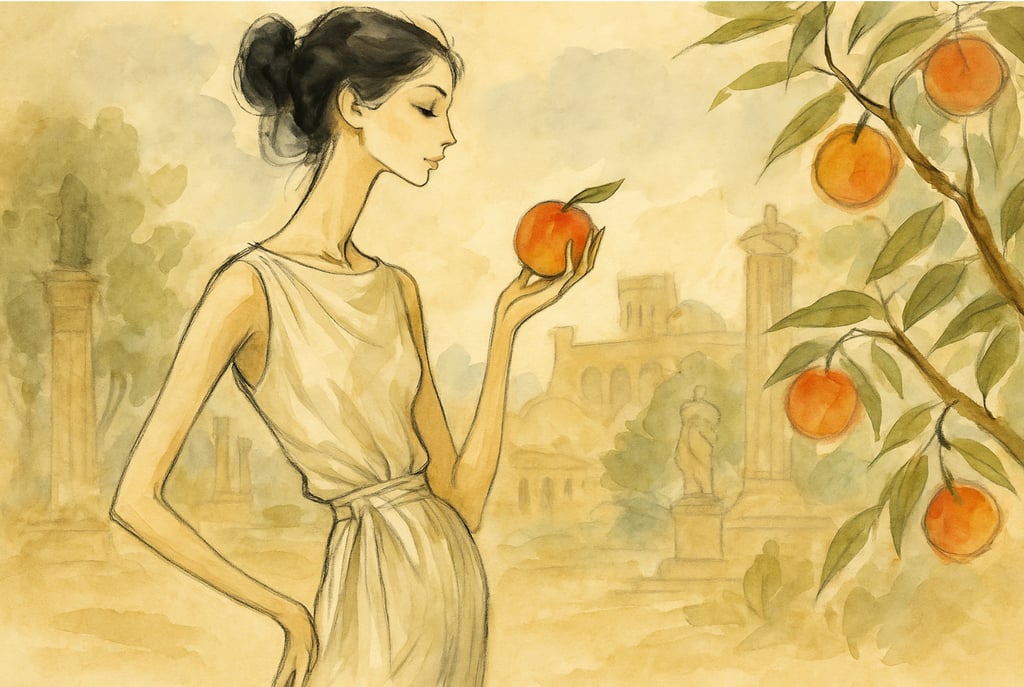Peaches, Poisons, and the Persian Empire: A Fruit of Eternal Youth—or Death
In the Persian Empire, peaches symbolised youth and vitality—but their kernels could kill. Discover how this sweet fruit became a royal delicacy and a deadly weapon.
FOOD HISTORY & TRADITIONS


Few fruits carry a history as paradoxical as the peach. To the Persian Empire, this delicate, blushing fruit was a symbol of vitality and beauty, believed to grant youth and renewal to those fortunate enough to taste it. Yet, beneath its sweet flesh, it held a hidden danger: a kernel that, when crushed, could kill.
The peach’s journey to Persia and its dual legacy—both as a celebrated luxury and a feared poison—reflect how food in the ancient world was never just sustenance. It was status, ritual, and sometimes, a weapon.
From China to Persia: The Peach on the Silk Road
The peach’s origins lie in China, where it was cultivated as early as 2000 BCE and revered as a sacred fruit. In Chinese legend, peaches symbolised immortality and divine favour, their blossoms associated with spring and renewal. Traders along the Silk Road carried the fruit westward, where it found fertile ground in the orchards of Persia by around the first millennium BCE.
In Persia, the peach quickly took on its own layers of meaning. The royal courts, ever keen to adopt exotic luxuries, embraced it not only for its flavour but for the aura of mystique it carried. It became known as shahloo—literally “king’s fruit”—a name that reflected both its prestige and the exclusivity of its cultivation in palace orchards.
To be served peaches at a royal banquet was to be honoured; they were seen as tokens of health, prosperity, and even divine blessing, often featured in offerings to deities or shared during seasonal festivals.
The Peach as a Symbol of Eternal Youth
Like its Chinese legacy, the peach in Persia was soon tied to youth, beauty, and vitality. Its soft, fragrant flesh and blushing colour made it a natural emblem of renewal and desire. Courtiers and poets alike wove it into imagery, likening the fruit to flushed cheeks and delicate skin.
In some traditions, it was believed that regular consumption of peaches, especially when paired with honey or rosewater, could preserve one’s complexion and extend one’s lifespan. Bowls of peaches often adorned the tables of noblewomen, and records suggest that they were used in cosmetics, their oils and scents incorporated into balms and perfumes.
But this association with youth and beauty also fed into its darker side. The same kernels believed to contain potent life-giving oils could, in the wrong hands, deliver death.
The Poison in the Pit
Like many stone fruits—apricots, cherries, almonds—the seeds inside peach pits contain amygdalin, a compound that releases cyanide when metabolised. In small amounts, these kernels were used medicinally, as their bitter oils were thought to aid digestion or ease pain. But in larger doses, they could be deadly.
Historical accounts and later folklore suggest that Persian assassins and scheming courtiers may have exploited this property, grinding peach kernels into powders or oils to create subtle poisons. These toxins could be mixed into food or drink, often without immediate detection, making them tools of discreet political elimination.
While direct records are scarce—poisonings were often covered up to avoid scandal—the fear was real enough that royal tasters were employed to sample every peach served to kings and nobles. In a world where luxury and danger often intertwined, the peach became a symbol not only of life’s pleasures but also its risks.
Fun Fact: A Fruit for the Brave (and the Paranoid)
The Persian word shahloo—“king’s fruit”—captures its dual nature. Peaches were fit for rulers, yet their association with poison made them a source of anxiety at royal feasts. Some kings reportedly avoided eating the fruit altogether unless a trusted servant first demonstrated its safety, a ritual that turned every peach into a quiet drama of trust and survival.
The Peach in Persian Culture and Legend
Beyond its role as food and potential poison, the peach embedded itself in Persian culture as a symbol of desire and mortality. Poets compared its soft, downy skin to the blush of young lovers and its fleeting season to the fragility of life and beauty. Its very duality—the pleasure of its taste and the peril of its seed—made it a natural metaphor in literature for love, ambition, and the dangers of excess.
Some tales even ascribed mystical qualities to the peach pit, suggesting it could be used in charms or amulets, either to protect the wearer from harm or, paradoxically, to curse rivals. Whether these stories were rooted in fact or fear, they deepened the peach’s reputation as a fruit that straddled the line between blessing and curse.
A Legacy of Duality
Today, we rarely think of peaches as dangerous—though their kernels still contain amygdalin, the risk is negligible when the fruit is eaten normally. Yet their Persian legacy lingers in the way we still connect peaches with luxury, sensuality, and beauty. In art and language, they remain shorthand for vitality and allure, echoes of a time when they were reserved for kings and courtiers, both coveted and feared.
The peach’s journey from Chinese orchards to Persian palaces is a reminder of how foods acquire stories as they travel: myths, warnings, and meanings layered over their physical presence. For the Persians, each bite of peach carried the weight of both promise and peril, a taste of eternal youth that could, in the wrong hands, deliver eternal silence.
